Interactive Fellows Friday Feature!
Join the conversation by answering Fellows’ weekly questions via Facebook. This week, Jessica asks:
Would you consider watching community media as part of the news you consume? Would you prefer to watch a news report about, say, an earthquake in Pakistan, by someone who had lived through that earthquake, or by a professional journalist?
Click here to respond!
What is Video Volunteers all about?
Video Volunteers (VV) teaches communities in the developing world to tell their stories with video. We have created a grassroots journalism network of about 150 people who work in slums and villages across India, primarily. They make films on different issues like water, sanitation and health.
Our Community Video Units (CVU) are local production units run by eight to ten community members who are trained in all aspects of video production. They work full-time and receive a salary. Each CVU has digital video cameras, computers for editing, a TV, and a wide screen projector and sound system for outdoor screenings. Community Producers show their films to 300 or 400 people per night in their villages, and then they have discussions around the solutions that are put forward in the films. We create CVUs with some of the leading NGOs in India.
So our main program is these Community Video Units. Basically, it’s hyper-local news for people in severely media-deprived areas. And the purpose is really to get communities to take action on their issues. These Community Video Units have made 50 or 60 films in the last 3 or 4 years. All of them have very concrete instances of people taking action, usually around people organizing rallies, going to government offices, or accessing government services. There are even lots of instances where roads get repaired, or electricity comes to the villages, even before the video is shown, just because of the pressure on the government that is created.
The other major program that we run is similar. It’s called “India Unheard,” and it’s the same type of people — from the poorest backgrounds — producing the news. However, instead of showing it in their villages, it’s for outside audiences. Different NGOs pay Community Producers to do campaigns on their issues. We really look at how you can monetize this content.
What’s the latest and greatest from Video Volunteers?
We’re about to start a half-hour weekly news show with one of the television stations here. We’re really excited about it, because it’s the first time, anywhere in the world, that a major news station has deigned to “dignify” community-produced content in this way. That will be launching in the middle of this month. We’re really excited about that, because part of what we believe — and this show will kind of test this out — is that who produces the news is nearly as important as what the news is. The world looks different through the eyes of these communities.
We know what corruption and maternal mortality, and other world poverty/human rights issues look like from the point of view of urban reporters, looking down and seeing it. But what does it look like to people who live there? And is that perspective different and unique enough that maybe it can start to pique people’s interest in a different way?
We have also just completed a 10-month project working with young people in the favelas of Sao Paolo to help them set up media businesses. The reason we went to Brazil is that it has more alternative media than any country in the world. But the issue is that there’s very little thinking about how to make it become a livelihood. It’s lots of short-term empowerment stuff. Kids go to these programs, have an amazing experience, and then they go back to their really difficult jobs and lives. So we developed a curriculum for how NGOs could integrate a livelihoods focus into their media work.
You’ve said the films produced by the Community Producers have had a lot of concrete impacts.
There are many examples of incredible impacts on communities — some are posted to the Video Volunteers website. But the impact is really most tangible on the Community Producers, because they’re the direct recipients. The community is kind of a level removed.
One incredible Community Producer is a 22-year-old Dalit girl named Neru — the youngest of 12 girls in her family! Twelve girls in an incredibly feudal part of Gujurat.
I went to a screening there a couple of years ago, and the day that I had been there, a little girl had had her arms broken for refusing to go to work in the fields for one of the local upper castes. This kind of stuff really happens, and that’s what it means to be a Dalit. Neru has married one of the boys in the Community Video Unit. So she is personally kind of taken care of, because she has this wonderful husband, who has learned about the importance of respecting women through working in the CVU. This is so different from the kind of marriage either of them could have expected in life.
Neru stands up a few nights every month for her screenings, making speeches in front of 800 people in her village. She introduces the film, and then afterwards says, “Who’s going to do something about this?” She does this amidst cat-calling and all kinds of stuff. But she puts up with it. Fortunately, she also has real people who defend her and want her to succeed.
A couple months ago Neru took 300 people to a government office to make use of a law where the government guarantees 100 days of employment to the rural poor. It’s a new law, not very many people know about it. They made a video about it, and she took 300 people to take advantage of this opportunity. Police have tried to recruit her for their forces because she goes out on raids with them when she makes videos about illegal activity. And Neru drives her own rickshaw now. It’s really inspiring the way that this has changed some of these people.
You know, we could be doing something else besides journalism training. We could be organizing people around water, or organizing teachers, or something like that. But journalism training in the realm of grassroots NGO work is quite interesting. Because what trainees learn is how to talk about anything. So they know a little bit about how the electoral system is supposed to work. They know all the government officials because they’ve interviewed them. They know about health, they know about water — they’ve made films on all these things. So they really are very well-rounded.
The Community Producers become the go-to points in their villages for all kinds of things. We see this across the board in all the places. But the effect is most profound on the women, because the women have the farthest to come. Everybody’s getting the same training. But for the women, who were almost all housewives staying at home before this, it’s the most empowering.
Video Volunteers is clearly great for Community Producers and their communities. Is it important for the rest of the world?
One of the major things that concerns me is the lack of diversity in mainstream media. Both in terms of who is producing and what is being produced. News is overwhelmingly — especially in a country like India — produced by the top 1 or 2 percent. That lack of diversity really concerns me. I think the world should take notice of that, and people should be more upset about than they are. We make sure that our network is a quarter Dalit, a quarter Muslim, a quarter tribal, and more than 50 percent of every program that we do has to be women.
In terms of what is being produced … do we need to have hyper-local just for the sake of it? Not really. But in this place, it’s a question of the media not providing what people need. India has a media that’s become just totally modeled on media in the US. Middle class Americans do care about stuff like fashion and celebrities. But that’s absolutely not true for the people we work with here in India.
We do surveys when we start our projects. People here want information about jobs, health, government programs and services they can get, environment, monsoons, elections … all this kind of stuff that to us is is “news on poverty,” not relevant to our daily lives. But to them it’s stuff that they need to know.
I sometimes feel like the lack of information is a bit like if you lived in New York City, and one day you left for work and there was no subway. Imagine if the subway just wasn’t running. And for the next five years it wasn’t running. And you had no idea why. Nobody was telling you what this was about. Maybe there were filmmakers that came up to you and interviewed you all the time about how upset you are about the fact that there’s no 6 train anymore, but you had no idea yourself what was going on. That’s what the situation is in these places.
There are many aspiring social entrepreneurs out there who are trying to take their passion and ideas to the next level. What is one piece of advice you would give to them based on your own experiences and successes? Learn more about how to become a great social entrepreneur from all of the TED Fellows on the Case Foundation blog.
To keep working at it. Don’t give up. It takes a lot of persistence. I’ve been doing this for seven years. That’s a really, really long time. I’ve been my own boss since I was 25 years old. There’s so much that I have to teach myself, or try to suss out from mentors. And I think it’s a lot about persistence.
When young people wanting to do social entrepreneurial ventures come to me looking for advice, I try to assess how thick-skinned the person seems. Do they seem that they can put up with the loneliness of this? The feeling of being so insignificant? The feeling of going every single day to ask other people for help, money, contacts? It’s really exhausting, when you could be having quite a clear, straight-forward job. So persistence is something that’s really important.
And the other thing is to really go out there and do it yourself. Especially if we’re talking about people doing stuff in the developing world, I think there’s a big difference between the people sitting in New York and trying to get their project off the ground in Africa, and the ones who are going out to Africa and just doing it. You’ve got to be out in the field. And that’s the important thing. Even if your venture fails, it’s still been an incredible life experience for you. You’ve still learned a huge amount.
What was your inspiration for starting Video Volunteers?
I was working in TV in New York at CNN and the Fox News Channel and Court TV after college. I was very young so these were Production Assistant, Associate Producer sort of roles. I found that experience incredibly disillusioning. I kind of taught myself how to shoot, write and edit, like one can these days in a week. Like we’re now teaching these Community Producers to do in a month or two.
I came to India as a Fellow of the American India Foundation, which has a volunteer program, thinking I’d be here for nine months. I worked at a very big, successful NGO in Ahmedabad that had a participatory video program — one of the oldest ones in the country.
It was very inspiring that these very, very rural women were capturing these really interesting stories, and they were doing everything themselves. I was coming from unionized television in New York, where you never saw women operating cameras. It’s all men in TV in New York. And here were these women in their saris in the villages with these big Betacams — this was still 2003, and they had barely gone digital.
It was very inspiring, but on the other hand, there were certain problems with it. These women had been making films for 20 years, but their creative skills, their level of articulation was really, really low. They were just technical operators. They knew how to operate the camera, and they knew how to edit. They didn’t know how to write scripts. They didn’t know how to conceive of films. So that got me quite interested in this whole idea of “How do you teach critical thinking? How do you teach these higher level intellectual skills?”
In the NGO world, so much of what people are teaching is incredibly important, because it often gives people a livelihood. But teaching technical skills is in a different order than teaching people how to really go through the complex process of identifying a problem, researching a solution, figuring out who to talk to about it — you know, what you get from journalism training.
So I went back to New York at the end of my nine months with the idea of doing — surprise, surprise — a volunteer program for filmmakers. Because that’s basically what I had been doing. So I did that in my bedroom for about two and half years. Just me and my computer and no money. A big plus was that I’m from New York, so I could live for free with my parents in a city that is a center of so much great international development work. That is an unfair advantage I had. This was a good R&D period. I sent volunteers to about 20 different organizations, with the volunteers bearing their own costs, and the NGOs bearing their own costs.
But there was only so far that that could go. When we came up with the Community Video Units idea in 2006, it was a watershed moment for us. It was a better idea, we were able to attract some funds, and it just took things to a different level. It wasn’t just me in my bedroom anymore.
How has the TED Fellowship impacted your work?
Boy, in a lot of ways. One of the really wonderful connections was at TEDIndia with Abhay Deol who was one of the speakers, a famous Bollywood actor here. He’s become VV’s media ambassador. And he’s just been fabulous for us. He talks about us in the press all of the time. He articulates our message incredibly well. We organized this screening in the slums in Bombay for him and a couple other celebrities he brought. Everybody was so excited, it was so much fun. All the Community Producers just loved it. They showed their films, he gave this fabulous speech, talking about how this is the best, this is so much better than what they’re making in Bollywood, which of course is not true, but he’s just incredibly motivating. He’s come to a bunch of our trainings. So that’s one really good connection.
It was also one of the first times I had met a lot of media companies. I met Google, Microsoft, Nokia, and other people of that ilk. These are the kinds of people that I’m still corresponding with, and trying to approach in the right way, but they know us now. And those are really important kinds of possible collaborations for an organization like ours.

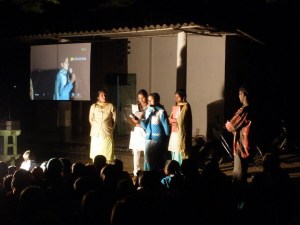
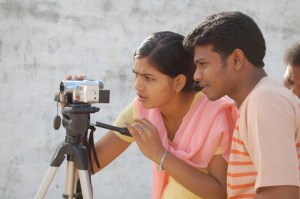
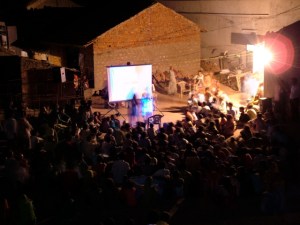
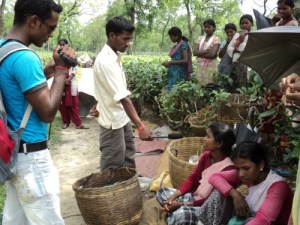
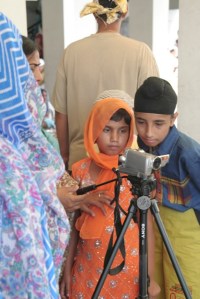
Comments (2)
Pingback: India's citizen journalists tell a few home truths - Global Progress
Pingback: Fellows Friday with Jessica Mayberry « TEDxMuscat